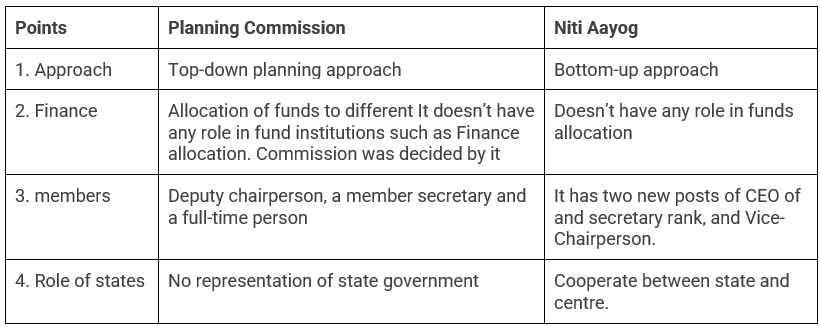GS3 PYQ (Mains Answer Writing): NITI Aayog | Indian Economy for UPSC CSE PDF Download
How are the principles followed by NITI Aayog different from those followed by the erstwhile planning commission in India? (UPSC MAINS GS3 )
The NITI Aayog, established in 2015, is one of India’s youngest institutions. It is mandated to foster cooperative federalism, evolve a national consensus on developmental goals, redefine the reforms agenda, act as a platform for resolution of cross-sectoral issues between Center and State Governments, capacity building and to act as a Knowledge and Innovation hub. It has been entrusted with the mandate of re-imagining the development agenda by dismantling old-style central planning.
- Planning Commission: The Planning Commission from 1950 to 2014 formulated twelve five year plans. An internal evaluation in Government revealed that Planning Commission was witnessing policy fatigue necessitating structural changes in central planning process. The assessment identified that the collapse of public investment in the face of rising subsidies, huge demands on public resources from the Right to Education Act, the National Rural Employment Guarantee Act and a poorly targeted Public Distribution System. Further rigid labor laws were impeding progress, and there were difficulties in releasing land for public housing and other public projects.
Thus a new Institutional framework was needed Works undertaken by NITI Aayog
- The NITI Aayog formulated the Make in India Strategy for Electronics Industry, a Model Land Leasing Law, laid down a National Energy Policy, prepared a Roadmap for Revitalizing Agriculture, designed a Developmental Strategy for North East and Hilly areas and undertook an appraisal of the 12th Five Year Plan.
- An agricultural transformation was envisaged with the objective of doubling farmer’s income by 2022.
- Further, it monitors the implementation of the Sustainable Developmental Goals.

Thus, NITI Aayog has undertaken path breaking work in last years and the nation can look forward to the Institution imparting a new dynamism to India’s developmental process in the coming years.
Topics covered - NITI AAYOG
|
138 videos|431 docs|128 tests
|
FAQs on GS3 PYQ (Mains Answer Writing): NITI Aayog - Indian Economy for UPSC CSE
| 1. What is NITI Aayog and what is its role in the UPSC exam? |  |
| 2. What are the key initiatives taken by NITI Aayog in recent years? |  |
| 3. How does NITI Aayog promote cooperative federalism in India? |  |
| 4. What are the major differences between NITI Aayog and the Planning Commission? |  |
| 5. How does NITI Aayog contribute to sustainable development in India? |  |
















